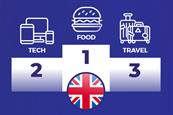
The UK government's first moves to ease the coronavirus lockdown are coming into force this week and backed by a new communications message. "Stay alert. Control the virus. Save lives" has replaced "Stay home. Protect the NHS. Save lives".
 There has also been a change of colour on the messaging to a more positive green and yellow from the previous hazard-style red and yellow (pictured, left).
There has also been a change of colour on the messaging to a more positive green and yellow from the previous hazard-style red and yellow (pictured, left).
That sends a tacit signal that the UK wants to restart the economy after eight weeks of near-total quarantine at home.
However, opposition political leaders have claimed the new "Stay alert" messaging is confusing.
Labour Party leader Sir Keir Starmer accused prime minister Boris Johnson of not giving the public "clear directions".
Nicola Sturgeon, first minister of Scotland, said it would be "catastrophic" to drop "Stay home" and refused to take on the new messaging. Wales and Ireland have also refused to adopt the new slogan.
So what does adland think of "Stay alert" – and does it work?
 Benedict Pringle
Benedict Pringle
Founder, politicaladvertising.co.uk
A YouGov poll of more than 6,500 people conducted on Sunday and Monday found that just 30% of people said they felt they knew what the new slogan was asking them to do. Existing political preference does impact the result; for example, Conservative and Leave voters are less critical than Labour or Remain voters. But regardless of how one breaks down the data – by political affiliation, age group or geographic region – the prevailing sentiment in each segment is that the new messaging doesn’t convey the government’s expectations of the public.
 Bridget Angear
Bridget Angear
Joint chief strategy officer, Abbott Mead Vickers BBDO
Getting us out of lockdown was always going to be more complex than getting us into it. In Boris’ words: "Coming down a mountain is often harder than going up." The government’s new slogan, "Stay alert. Control the virus. Save lives" illustrates the difficulty of reducing a more nuanced strategy down into a simple statement.
As did communities secretary Robert Jenrick’s attempt to explain it: "Stay alert will mean stay alert by staying home as much as possible, but stay alert when you do go out, by maintaining social distancing, washing your hands, respecting others in the workplace and the other settings that you'll go to."
Hmm. That’s clear, then! I have to say I find myself siding with Scotland’s first minister on this occasion when she described it as "vague and imprecise". The next phase of how we deal with this horrendous virus may well be more complex. But we have to make sure it's not more confusing.
 David Golding
David Golding
Co-founder, Adam & Eve/DDB
It’s been panned from all sides: other politicians, journalists and even Phillip and Holly. But is ‘"Stay alert" so bad? I appreciate that "Stay home" was a definitive and clear statement and "Stay alert" isn’t, but it was for a much more definitive time in the battle against the virus. We are now moving to a more flexible stage, with different businesses, school years and even the nations in our union doing different things. There is no common and universal behaviour now. So the only thing that can be achieved is a common and universal vigilance.
I’m told all the best government lines are clear and actionable, like "clunk click". But that’s not the case. Is "Think!" for road safety any more direct than "Stay alert"? Is "Careless talk", that most famous of wartime posters? I assume "Stay alert" was authored by Dominic Cummings and he has a rather good track record with slogans. And there’s no doubt most of the population knows it already, whilst the average our industry achieves for most brand endlines is just 4%.
 Anna Vogt
Anna Vogt
Chief strategy officer, TBWA\London
It’s a big fat fail. Mostly because my definition of being alert may vastly differ from your definition. Whilst my state of alertness just about enables me to distinguish between salt and sugar for my morning porridge and remember most of the passwords I need for one day’s worth of WFH, it will fall short of identifying particles the size of 125 nanometers catapulting in my direction. But that might just be me.
"Stay at home" was a clearer directive. Because me staying at home is the same as you staying at home. Removing subjectivity and ensuring a consistent and collective response seems to be the thing that will help us get on top of this.
 Charles Vallance
Charles Vallance
Founding partner, VCCP
The easy answer is a Sturgeon-esque "no". It's a muddle, it's not clear, it shouldn't be allowed. But I wonder if the "Stay alert" messaging is intended as a process as much as an instruction.
The phasing of an announcement on Sunday evening, followed by a parliamentary debate 18 hours later, has allowed for an interregnum (in which I am writing this) where all our questions and equivocations can surface.
Only when the "Stay alert" messaging has successfully addressed these FAQs will we be able to properly judge its success. It is out of necessity more nuanced than a simple "Stay at home" enforcement message and thus inevitably more vague.
But it may yet help in the transition from a post-lockdown to a pre-vaccine reality, where we will gradually move from the clarity of blanket rules back to the complexity of more individualised decision-making based on an intricate matrix of personal circumstances.
The real test for messaging during this process will be its ability to accommodate such a range of differing needs.
 Richard Huntingdon
Richard Huntingdon
Chairman and chief strategy officer, Saatchi & Saatchi
Stay alert? You have to be pretty bloody alert to keep on top of the government’s messaging on Covid-19. Just when we had a message that was clear, unequivocal and we could all remember, recite and act upon, they go and change it. And change it for something that has all the clarity and precision of a sundial on a cloudy day. Added to the bizarre decision to replace the arresting and effective "red for emergency" art direction with some "green for go" bunting, what we have is a recipe for confusion, chaos and personal interpretation. The backtracking and clarification that has been necessary just a day after its unveiling is testament to this sad truth.
 Jules Chalkley
Jules Chalkley
Chief executive creative director, Ogilvy UK
Stay alert? I have been since January. Like a wolverine. All it does is reinforce an existing behaviour.
The issue is that the original expression "Stay home" is almost too successful. It’s unequivocal, it gave us all a clear role to play. It was also accompanied by quite a frightening new image of the world: masks, blue lights and hospitals.
We slammed our front doors and now reports suggest 90% of the population aren’t in a rush to go back outside.
Whatever messaging framework follows, it has to be equally powerful, verbally and visually, to help us get back past our front doors and into the world.






